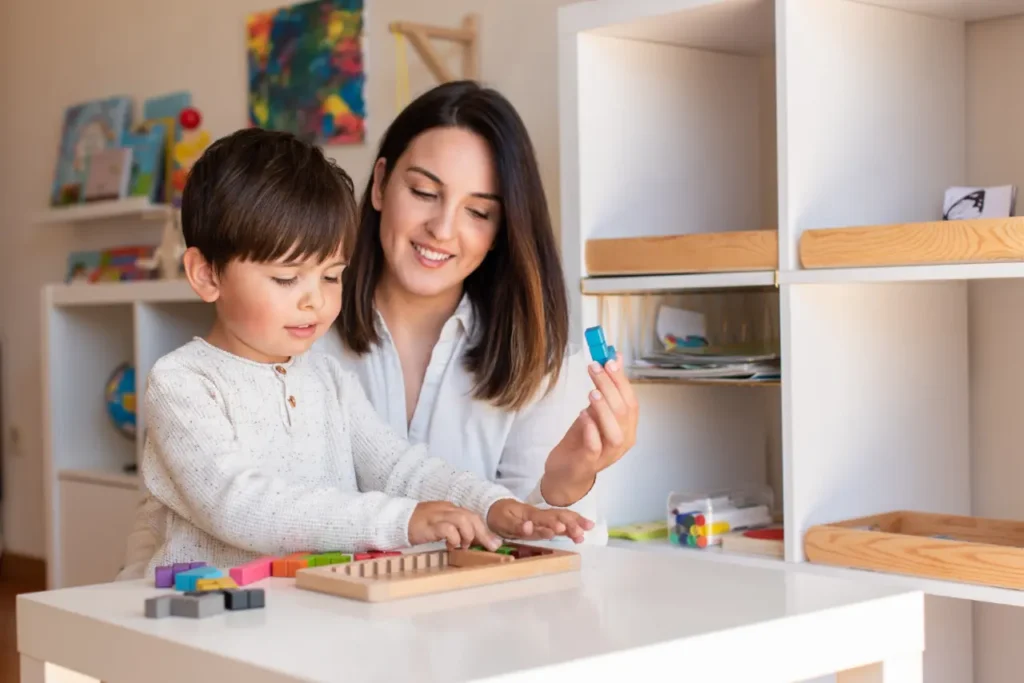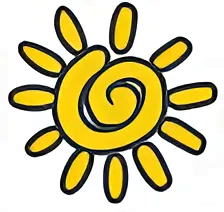Engaging your preschooler in learning activities at home can be a rewarding experience. It can also be a challenge.
Montessori activities for preschoolers offer a solution. They are designed to foster independence and hands-on learning.
These activities are based on the Montessori philosophy. This approach respects a child’s natural psychological development.
In this guide, we will explore 10 Montessori activities you can try at home. These activities are suitable for preschoolers aged 3-6.
We will also discuss how to create a Montessori-inspired environment at home. This includes tips on selecting Montessori educational toys.
Whether you’re a parent, caregiver, or educator, this guide is for you. It’s time to make learning fun and meaningful for your preschooler.
Let’s dive into the world of Montessori activities for preschoolers.
Understanding Montessori Education
Montessori education is a child-centered approach. It was developed by Dr. Maria Montessori, an Italian physician and educator.
This method emphasizes independence and respect for a child’s natural psychological development. It encourages hands-on learning and self-directed activity.
In Montessori education, children make creative choices in their learning. Teachers and parents act as guides, providing an environment that fosters exploration.
Creating a Prepared Environment at Home
A key aspect of Montessori education is the prepared environment. This is a space designed to meet the needs, interests, and abilities of the child.
The prepared environment at home should be safe, engaging, and accessible. It should include child-sized furniture and materials that are within easy reach.
Remember, the goal is to encourage independence and self-directed learning. This can be achieved by organizing materials on low shelves and providing tools that the child can handle safely.
The Role of the Adult in Montessori Activities
In Montessori education, the adult plays a unique role. They are not the center of attention, but rather a guide and facilitator.
The adult’s role is to prepare the environment, observe the child, and intervene only when necessary. This allows the child to explore, learn, and grow at their own pace.
Remember, the goal is not to control but to inspire. The adult should respect the child’s work, encourage their efforts, and foster a love of learning.
Activity 1: Pouring and Transferring Exercises
Pouring and transferring exercises are simple yet effective Montessori activities for preschoolers. They help develop fine motor skills and control, which are crucial for writing and other tasks.
Start with two small pitchers or cups and some dry beans or rice. Have your child pour the beans or rice from one container to the other. As they master this, you can introduce variations like using a spoon for transferring or pouring liquids.
Remember, the goal is not perfection but practice. It’s okay if they spill. Cleaning up can be part of the activity, teaching responsibility and care for the environment.
Activity 2: Dressing Frames for Practical Life Skills
Dressing frames are a staple in Montessori classrooms, and they can easily be replicated at home. They help children learn practical life skills like buttoning, zipping, and tying.
You can create a dressing frame using an old picture frame and a piece of clothing. Attach a shirt with buttons or a jacket with a zipper to the frame. Encourage your child to practice fastening and unfastening.
This activity not only develops fine motor skills but also promotes independence. Your child will take pride in being able to dress themselves. Remember, patience is key. Allow your child to take their time and master each skill at their own pace.
Activity 3: Sensorial Exploration with Sound Boxes
Sound boxes are a fantastic way to engage your preschooler’s sense of hearing. They are simple to make at home using small containers and various materials that produce different sounds.
Fill pairs of containers with items like rice, beans, or small bells. Ensure each pair makes the same sound. Then, mix them up and ask your child to match the pairs by listening to the sounds they make.
This activity enhances auditory discrimination and concentration. It’s also a fun way to introduce the concept of ‘same’ and ‘different’. Remember, the goal is not to rush but to allow your child to explore and discover at their own pace.
Activity 4: Alphabet Tracing for Language Development
Alphabet tracing is a key Montessori activity for language development. It helps preschoolers learn letter shapes and sounds, preparing them for reading and writing.
You can create your own alphabet tracing cards using sandpaper letters glued onto cardstock. Encourage your child to trace the letters with their fingers while saying the corresponding sound.
This tactile experience aids in memory retention and fine motor skill development. It’s a simple yet effective way to introduce literacy skills in a hands-on, engaging manner. As always, follow your child’s lead and let them explore the letters at their own pace.
Activity 5: Counting with Bead Strings
Bead strings are a classic Montessori material for introducing counting and number concepts. They provide a visual and tactile way for children to understand quantities and their relationships.
You can make your own bead strings at home using beads and string. Start with strings of 1-10 beads, each string representing a number. Encourage your child to count the beads and match them with the corresponding numeral.
This activity not only helps children understand the concept of numbers, but also develops their fine motor skills as they manipulate the beads. Remember to let your child explore and discover at their own pace, reinforcing the Montessori principle of self-directed learning.
Activity 6: Simple Science Experiments at Home
Science is a fascinating subject for preschoolers. It allows them to explore the world around them and understand how things work. Simple science experiments can be a great way to introduce your child to scientific concepts.
For example, you can set up a plant watering experiment to teach your child about the needs of living things. Use two plants, water one and not the other, and observe the differences over time. This activity not only teaches your child about plant biology, but also instills a sense of responsibility as they care for the plant.
Remember, the goal is not to teach complex scientific theories, but to spark curiosity and foster a love for learning. Let your child lead the experiment, make observations, and ask questions. This aligns with the Montessori principle of child-led learning.
Activity 7: Art and Creativity Projects
Art is a wonderful way for children to express themselves. It encourages creativity, improves motor skills, and can be a calming activity. Montessori activities for preschoolers often include art projects that allow for open-ended exploration.
One idea is to set up a collage making station. Provide your child with different materials like colored paper, fabric scraps, and natural items like leaves or flowers. Let them create their own artwork. This activity not only fosters creativity but also enhances fine motor skills as they handle and arrange the materials.
Remember, the process is more important than the product in Montessori education. Encourage your child to explore, experiment, and enjoy the process of creating, rather than focusing on the end result.
Activity 8: Exploring Geography with Maps and Flags
Geography is a key part of the Montessori curriculum. It helps children understand the world around them. It also fosters a sense of global awareness and respect for different cultures.
You can introduce geography to your preschooler through simple activities. For instance, use a world map puzzle. This activity not only teaches about different countries and continents, but also enhances spatial reasoning and problem-solving skills.
Another idea is to explore flags of different countries. You can make a game out of it. Match flags to their respective countries on the map. This activity not only introduces your child to different nations, but also colors and symbols. Remember, the goal is not to memorize all countries or flags, but to spark curiosity about the world.
Activity 9: Music and Movement Activities
Music and movement activities are integral to Montessori education. They foster creativity, rhythm, and coordination. Plus, they’re a lot of fun for preschoolers!
You can start with simple rhythm games. Use musical instruments like tambourines, maracas, or even homemade shakers. Encourage your child to follow a beat or create their own. This activity enhances listening skills and introduces the concept of rhythm.
Dancing is another great way to incorporate movement. Play different types of music and encourage your child to move freely. This not only helps in physical development but also allows your child to express themselves. Remember, the goal is not to teach specific dance moves, but to encourage free expression and enjoyment of music.
Activity 10: Practical Life Tasks – Cooking and Plant Care
Practical life tasks are a cornerstone of Montessori education. They help children develop independence, coordination, and a sense of responsibility. Cooking and plant care are two such activities that can be easily incorporated at home.
For cooking, start with simple tasks like washing fruits, spreading butter on bread, or mixing ingredients. Always supervise your child during these activities for safety. These tasks not only help in developing fine motor skills but also introduce your child to the concept of self-care and nutrition.
Plant care, on the other hand, can be a wonderful way to introduce your child to nature and science. Let your child water the plants, clean the leaves, or even plant seeds. This not only teaches them about the life cycle of plants but also instills a sense of responsibility and care for the environment.
Observing and Following the Child’s Interests
In Montessori education, observing the child is key. It helps you understand their interests, strengths, and areas for growth. By observing, you can tailor activities to suit your child’s unique needs and interests.
For instance, if your child shows an interest in animals, you could incorporate animal-themed activities. This could be animal puzzles, books about animals, or even a visit to a local farm. The goal is to fuel their curiosity and make learning enjoyable.
Remember, every child is unique. They learn at their own pace and in their own way. By observing and following their interests, you can create a learning environment that is engaging, fun, and effective.
Incorporating Montessori Principles into Daily Routines
Montessori principles can be seamlessly integrated into your daily routines. This approach can turn mundane tasks into meaningful learning experiences. For instance, meal preparation can become a practical life activity where your child learns to peel, chop, and mix ingredients.
Similarly, cleaning up after playtime can teach responsibility and order. Encourage your child to put toys back where they belong. This not only keeps your space tidy but also fosters a sense of ownership and respect for their environment.
Remember, the goal is not to rush through tasks but to engage your child in the process. This approach can make everyday routines more enjoyable and educational for your preschooler. It’s all about finding learning opportunities in the ordinary and making the most of them.
Conclusion: Embracing Montessori at Home
Embracing Montessori at home is about creating a nurturing environment that fosters your child’s natural curiosity and love for learning. It’s about providing opportunities for hands-on exploration and independent discovery.
Remember, the goal is not perfection but progress. It’s about observing your child, following their interests, and guiding them towards mastery at their own pace. With patience, consistency, and a little creativity, you can turn your home into a Montessori-inspired haven of learning for your preschooler.


